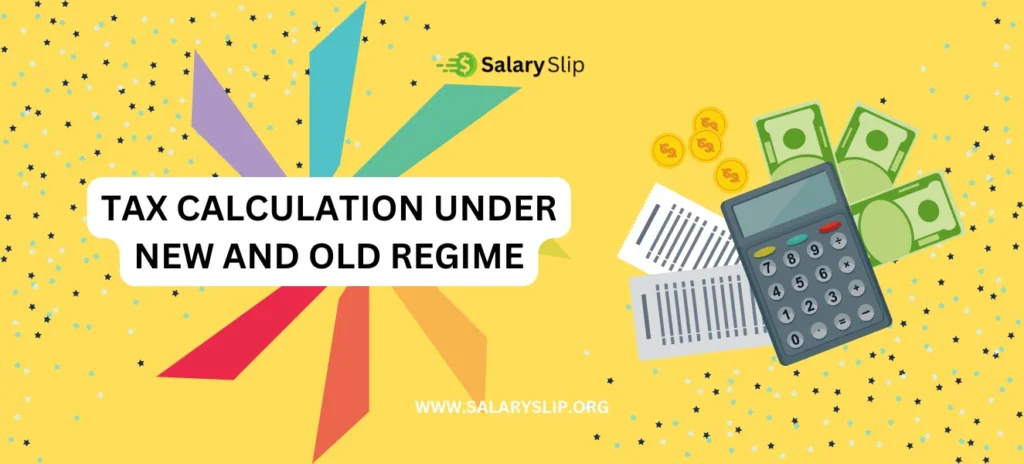Taxes are a necessary part of the economy that works closer to the development and welfare of society. But we can not ignore the truth that higher tax prices can on occasion impose a financial burden on the taxpayers, mainly the high-salaried people.
Optimizing tax financial savings while adhering to salary tax legal guidelines is no less than mastering a complex art. If you earn above or around ₹20 lakhs in India, then the right tax planning and control could make a large distinction to your financial health, and if you want to Save Income Tax For Salary Above 20 Lakhs then read this article till the end.
The right news is, that there are some reliable methods to reduce your tax burden at the same time as per tax legal guidelines. In this blog, we can walk you through all those effective tax-saving ways and assist you in better tax planning for a 20 lakhs salary. Read on!
What are the Income Tax Slabs below the New Regime vs the Old Regime?
A taxpayer is required to calculate and pay taxes based on the slab to which he/she belongs. Given below are the slab rates under the new and old regimes
| Annual Income | Old Tax Regime | Annual Income | New Tax Regime |
|---|---|---|---|
| Up to 2.5 lakhs | Nil | Up to 3 lakhs | Nil |
| 2.5 lakhs to 5 lakhs | 5% | 3 lakhs to 6 lakhs | 5% |
| 5 lakhs to 7.5 lakhs | 20% | 6 lakhs to 9 lakhs | 10% |
| 7.5 lakhs to 10 lakhs | 20% | 9 lakhs to 12 lakhs | 15% |
| 10 lakhs to 12.5 lakhs | 30% | 12 lakhs to 15 lakhs | 20% |
| 12.5 lakhs to 15 lakhs | 30% | 15 lakhs and above | 30% |
| 15 lakhs and above | 30% |
Also Read:- Calculate Your Income Tax Above 15 Lakh | Income Tax Slab Rates for AY 2024-25
Tax Saving Options Above 20 Lakhs Salary – New Tax Regime

The new tax regime gives lower and simplified tax fees however, it gets rid of most deductions and exemptions. Taxpayers opting for the new regime cannot claim deductions under sections consisting of 80C, 80D, 24(b), etc. While deductions are not allowed, taxpayers can declare the standard deduction and sure exemptions on particular allowances.
| Income Tax Slabs | Tax Rates |
|---|---|
| Up to Rs.3,00,000 | Nil |
| Between Rs. 3,00,001 to Rs.6,00,000 | 5%( tax rebate u/s 87A is available) |
| Between Rs.6,00,001 to Rs. 9,00,000 | 10%( tax rebate u/s 87A is available up to 7 Lakhs) |
| Between Rs.9,00,001 to Rs. 12,00,000 | 15% |
| Between Rs.12,00,001 to Rs. 15,00,000 | 20% |
| Above 15 Lakhs | 30% |
Tax Saving Options Above 20 Lakhs Salary – Old Tax Regime
The old tax regime follows the traditional salary tax slabs with various deductions and exemptions. Under the old regime, taxpayers can avail themselves of diverse tax exemptions and deductions under sections which include 80C, 80D, 24(b), etc. These deductions assist in reducing the taxable income, resulting in reduced tax liability. Taxpayers can declare House Rent Allowance (HRA), Leave Travel Allowance (LTA), and other allowances to reduce taxable income.
Old Tax Regime – Income Tax Slab Rates for FY 2024-25
| Income Tax Slabs | Individuals under 60 Years | Resident Senior Citizens Between 60 Years to 80 Years | Resident Super Senior Citizens above 80 Years |
|---|---|---|---|
| Up to Rs. 2,50,000 | Nil | Nil | Nil |
| Between Rs. 2,50,001 to Rs.3,00,000 | 5% | Nil | Nil |
| Between Rs. 3,00,001 to Rs.5,00,000 | 5% | 5% | Nil |
| Between Rs.5,00,001 to Rs. 10,00,000 | 20% | 20% | 20% |
| Above Rs.10,00,000 | 30% | 30% | 30% |
Must Read:- How is Gratuity calculated in CTC? | How to Answer “What Are Your Salary Expectations?” | Content Writer Salary
Tax Calculation Under New and Old Regime

Let us know the tax calculation for salary above 20 lakhs by example.
Example: Mr. A has a salary range of Rs 20 lakhs claiming deductions like HRA of Rs. 1,00,000, LTA of Rs. 20,000, Children’s education allowance for 2 children of Rs. 9,600, Professional tax of Rs 2,400. He claims deductions under 80C of Rs. A 1, 50,000, 80D – Medical coverage top rate of Rs. 25,000, and NPS contribution of Rs 50,000. Which is the satisfactory tax regime to opt for in this situation
| Particular | Old Tax Regime | New Tax Regime |
|---|---|---|
| Gross Salary u/s 17(1) | 20,00,000 | 20,00,000 |
| Less: Exemption u/s 10 | ||
| HRA Exemption | 1,00,000 | ❌ |
| LTA Exemption | 20,000 | ❌ |
| Children’s education and hostel allowance (for two children) | 9,600 | ❌ |
| Less: Deduction u/s 16 | ||
| Standard deduction | 50,000 | 50,000 |
| Professional Tax | 2,400 | ❌ |
| Income under the Head Salary | 18,18,000 | 19,50,000 |
| Less: Deduction under Chapter VI-A | ||
| Section 80C | 1,50,000 | ❌ |
| Section 80CCD(1B) | 50,000 | ❌ |
| Section 80D | 25,000 | ❌ |
| Net Total Income | 15,93,000 | 19,50,000 |
| Tax Liability (Including 4% Cess) | 3,02,016 | 2,96,400 |
How to Save Tax for Salary Above 20 Lakhs?
We already found out above that the right way to save taxes on salary slip is to avail most deductions to your taxable salary. Going with the same idea, the following table enlists the most variety of deductions that can be permissible and that you could declare during your Income Tax Returns (ITR) filing. Note that this case shares the deductions to be claimed for a worker filing ITR for FY 2023-24 for a CTC of as much as Rs. 2,00,000.
| Deductions Permissible on Income Tax | Total Amount Permissible (In Rs.) |
|---|---|
| House Rent Allowance (HRA) | Meal coupons like Sodexo are offered by the organization |
| Interest on home loan | 2,00,000 |
| Exemption under Section 80(C) of the ITA | 1,50,000 |
| Education for kids; Leave Travel Allowance (LTA); reimbursement on mobile phone and net payments; newspaper allowance; uniform allowance; present vouchers | 1,25,000 |
| EPF contributed by business enterprise | 1,25,000 |
| NPS contributed through enterprise | 1,00,000 |
| Gratuity (which is a part of CTC but not part of the salary and is exempted from tax) | 50,000 |
| Standard Deduction | 50,000 |
| NPS tax exemption under Section 80CCD(1B) | 50,000 |
| Health Insurance (each for self and for parents) | 50,000 |
| Meal coupons like Sodexo are offered by the organisation | 25,000 |
| Maintenance of car | 25,000 |
| Total Taxable Income After Deductions (Under Section 87A, Zero tax as much as Rs. 5,00,000) | 4,50,000 |
As can be seen from the table above, after claiming the most deductions within the ITR, the full taxable salary for the FY 2023-24 for a CTC of Rs. 20 lakhs comes to Rs. 4,50,000, that’s exempted from the tax rate under Section 87A of the Income Tax Act (falling inside the tax bracket under Rs. 5,00,000). Hence, the person with a CTC of 20 lakhs would need to pay 0 taxes or no taxes in this example.
Conclusion
Individuals earning a salary above ₹20 lakhs can make the most of those tax-saving options to lessen their tax legal responsibility. However, it’s important to note that the tax legal guidelines are tough to share, and it’s beneficial to consult a tax expert to ensure that you are availing of the tax benefits in a compliant manner.
Saving tax on a salary above 20 lakhs in India isn’t always impossible in case you plan your finances accurately and employ the various tax-saving options available. By deciding on the right tax regime, investing in tax-saving contraptions, buying health insurance, claiming HRA exemption, claiming other allowances and reimbursements, and making an investment in NPS, you can reduce your tax legal responsibility substantially and keep more money to your future goals.
FAQ’s:-
How do you save income tax on a salary above 15 lakhs?
If your taxable salary is as much as Rs. 15 lakhs, you could claim tax deductions really worth Rs. 10,000 at the interest earned on your savings bank account. This is according to Section 80TTA of the Income Tax Act.
What is the tax on a 20 lakh salary?
A tax of Rs. 3,51,000 is levied on a gross salary of Rs. 20,00,000 according to the new tax regime.
What is the tax on a 20 lakh salary?
A tax of Rs. 3,51,000 is levied on a gross salary of Rs. 20,00,000 according to the new tax regime.
